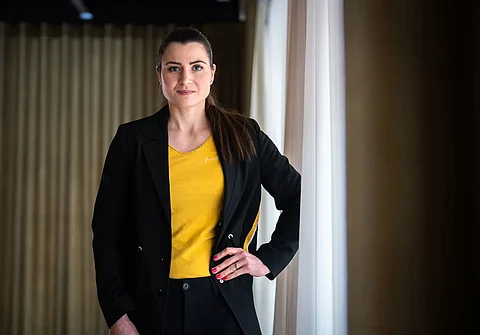

"We believe that a numerical requirement must be set where mortality falls to 5% within five years for all farming companies," says Tekna President Elisabet Haugsbø.
Photo: Tekna.
Norwegian professional body Tekna has called the fish mortality rate reported in Norway's Fish Health Report 2023 an "animal welfare crisis", and is calling on the Norwegian government to implement tighter regulations on salmon producers.
"It is wrong when the fisheries minister gives the impression that high mortality is due to the rules not being followed, the problem is that there are no clear limits for mortality. High mortality in practice has no consequences and animal welfare is largely left to the will of the individual farmer," said Tekna President Elisabet Haugsbø, in a Norwegian language article recently published on the Tekna website.
Haugsbø's comments coincide with the publication of the Norwegian Veterinary Institute's annual report on fish health, which revealed unprecedented levels of fish mortality during 2023.
A total of 62.8 million salmon (16.7%) and 2.5 million rainbow trout (14%) died in sea-phase production, while 37.7 million salmon and 2.4 million rainbow trout over 3 grams died during land-based smolt production. The total figure amounts to more than 100 million dead farmed salmon and rainbow trout in Norway last year.
Haugsbø points out that there are large differences in mortality between the various farming companies. While the average mortality in the industry in 2023 was almost 17%, according to the Norwegian Veterinary Institute, there are also many farms that manage to operate with a 5% mortality rate.
"We believe that a numerical requirement must be set where mortality falls to 5% within five years for all farming companies," Haugsbø said.
According to the Norwegian Veterinary Institute's Fish Health Report 2023, Norway recorded its highest-ever mortality rate of sea-phase salmon last year.
Photo: Stine Gismervik / Veterinærinstituttet - Norwegian Veterinary Institute.
Tekna's aquaculture division has undertaken its own investigation into fish health from its member's point of view, conducting a survey of fish health biologists to "map how they feel at work and to what extent their professional advice and assessments about the fish's health and welfare are listened to by the farmers."
The results reveal that fish health biologists in Norway experience a very high workload and encounter challenging professional dilemmas as part of their daily work. Most of these professionals work as contracted consultants for a variety of companies, and the majority said that relationships with their clients were generally good.
However, nine out of ten of those surveyed said they had experienced "burnout or physical problems" at work, with 60% considering quitting over their high workload.
Professional dilemmas, involving differences of opinion between the biologists and their clients are also a source of stress, according to the Tekna survey. One in four respondents said they were worried about contradicting their client's views regarding de-licing.
Tekna said their survey also showed that "a significant proportion feel that they have limited influence on decisions, and that their professional advice is not always taken into account".
The question of sea lice is at the heart of the issue, says Tekna. The organisation points out that sea lice levels are a determining factor in whether operators are permitted to expand production in Norway. However, treatment against salmon lice is one of the main causes of mortality and poor welfare in farmed fish.
A new metric needs to be brought in to judge the operators' performance, argues Tekna, shifting the focus from sea lice to fish mortality rates as an indicator of overall fish health and welfare.
"Tekna therefore believes that a new set of regulations must allow the number of dead fish in the farms to determine whether the farmers are allowed to expand production or not."
"High mortality must have consequences in the form of cuts in production, while low mortality can be rewarded with production growth," the organisation said.
Tekna is the latest organisation to publically criticise the situation over fish health and sea lice treatment in Norway's salmon farming sector.
In June 2023, Riksrevisjonen, Norway's National Audit Office criticised the Norwegian government for not having done enough to reduce the ongoing problems with poor animal welfare and high mortality in the salmon farming industry.
The National Audit Office said it had carried out an investigation which "shows that new technology and new production methods that weaken fish welfare have become widespread", and pointed out that the Norwegian Food Safety Authority Mattilsynet "believes that much of the development has taken place through trial and error, without the farmers having sufficiently documented the welfare consequences for the fish."
The government was failing to keep up with the pace of change, said Norway's Auditor General Karl Eirik Schjøtt-Pedersen: "The authorities do not sufficiently follow up the negative consequences that new technology and new forms of operation have on fish welfare," he said.
In November 2023, the then newly-appointed Fisheries Minister Cecilie Myrseth called for the Norwegian salmon industry to "clean up", following a spate of media reports about salmon diseases and fish processing irregularities.
"I think the industry needs to clean up. They need to take action. It is only they themselves who can ensure that they have trust and a good reputation among the population," Myrseth said at the time, in an interview with Norwegian business media E24.
Myrseth said that although it is her job to implement regulations and controls to ensure compliance, the salmon farmers themselves are reponsible for how they choose to operate. "It is the industry's own responsibility to actually follow the rules," she said.
